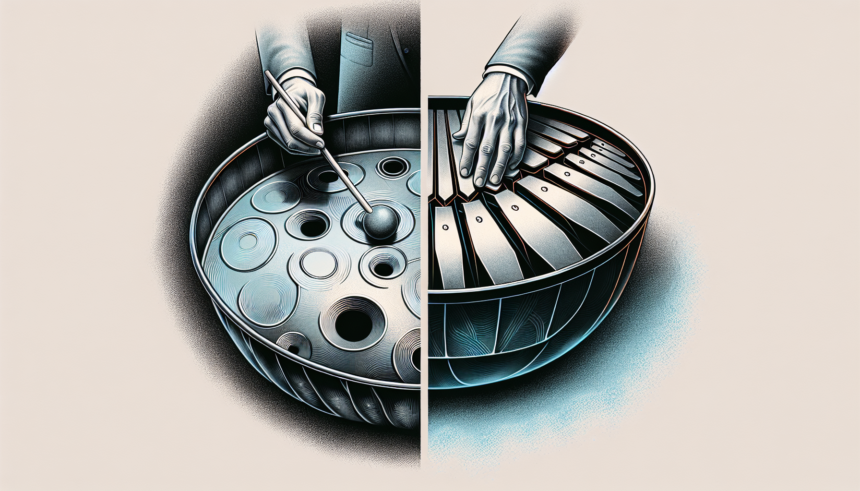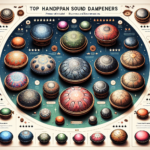The evolution of PANArt (PANArt Hangbau AG) from crafting traditional steel pans to creating the revolutionary Hang and other handpans is a fascinating journey of innovation and cultural fusion. This Swiss company, founded by Felix Rohner and Sabina Schärer, has significantly impacted the music world by transforming a Caribbean steel drum concept into a globally recognized musical invention. This article explores how PANArt’s dedication to exploration and craftsmanship pushed the boundaries of musical instrument design.
Origins of PANArt
PANArt started its journey by focusing on the traditional steel pans, instruments that originated in Trinidad and Tobago. The steel pan is a chromatically pitched percussion instrument made from industrial drums that have been carefully tuned to produce melodic sounds. Although these instruments were already known and appreciated, PANArt aimed to refine and evolve their design, focusing on enhancing the sound quality and playability.
Felix Rohner, a Swiss engineer and musician, first became fascinated with steel pans in the early 1980s. His quest for perfection led him to delve deep into the technicalities of steel drum crafting, experimenting with various materials and techniques. This pursuit was later bolstered by his partnership with Sabina Schärer, bringing a creative and innovative synergy to PANArt’s endeavors.
The Transition to the Hang
The major breakthrough for PANArt came in the early 2000s with the invention of the Hang (pronounced “hahng”). Unlike traditional steel pans, the Hang was designed to be played with the hands, merging elements from the steelpan, the gong, and other percussion instruments. Its creation was inspired by the desire to produce a more harmonious and meditative sound, suitable for hand play.
The Hang comprises two half-shells of nitrided steel joined at the rim, creating a hollow and resonant body. This innovative design features a central ‘Ding’ note with additional ‘tone fields’ arranged around it, allowing musicians to produce a wide range of harmonic overtones. The instrument is played by tapping and slapping, producing melodic and resonant tones that immediately captured the interest of musicians worldwide.
The unique sound and aesthetics of the Hang set it apart, making it a favorite among street performers, meditation practitioners, and professional musicians alike. Its creation marked a significant evolution in the field of musical instruments, adding a new dimension to the world of percussion.
The Handpan Revolution
Post the success of the Hang, PANArt ceased its production in 2013 to focus on new projects, leading to the development of other similar instruments known as handpans. The term “handpan” itself was coined by musicians and enthusiasts to describe the new generation of instruments inspired by the Hang’s design principles.
PANArt’s influence spurred numerous artisans and companies to explore the concept further, leading to a proliferation of handpans with varying designs, scales, and materials. Each new manufacturer brought their innovations to the table, creating a rich diversity within the handpan community.
PANArt, meanwhile, continued to innovate with instruments like the Gubal, a newer creation with an extended resonant cavity and unique tonal characteristics. Rohner and Schärer’s ongoing experimentation with sound and materials remains at the forefront of PANArt’s philosophy, always seeking new ways to enrich the musical landscape.
PANArt’s Commitment to Craftsmanship
Throughout its journey, PANArt has maintained a profound commitment to craftsmanship and quality. Each instrument produced by PANArt is a result of meticulous labor, combining traditional techniques with modern innovations. This dedication ensures that every instrument not only meets the highest standards of sound quality but also embodies the spirit and essence of PANArt’s mission.
PANArt’s approach to instrument making transcends mere craftsmanship; it is a deeply artistic process. The pursuit of perfect resonance, the selection of materials, and the intricate tuning processes all reflect a deep respect for the art of sound. This has cemented PANArt’s reputation as a pioneer and leader in the field of hand-crafted musical instruments.
Global Impact and Community
The global impact of PANArt’s instruments extends beyond their innovative designs and sound quality. The Hang and handpans have cultivated a vibrant international community of musicians, enthusiasts, and makers who share a passion for these unique instruments. This community is bound by the shared experience of exploring new musical possibilities and the joy of tactile, expressive play.
Festivals and gatherings dedicated to handpans have sprung up around the world, providing a platform for performers to share their music and techniques. This has fostered a culture of openness and collaboration that continues to drive the evolution of the instrument and expand its reach across varied musical genres.
Conclusion
From the humble beginnings of refining traditional steel pans to creating a completely new class of instruments, PANArt’s journey is a testament to innovation, perseverance, and passion for music. The Hang and its successors have not only enriched the musical landscape but also inspired a thriving global community. PANArt’s legacy is evident in the widespread popularity of handpans and the ongoing creative exploration they inspire. As we look to the future, PANArt continues to be a beacon of musical innovation, reminding us of the infinite possibilities that arise when craftsmanship meets creativity.
Frequently Asked Questions (FAQs)
1. What is the difference between a Hang and a handpan?
The Hang was the original instrument created by PANArt in the early 2000s, designed to be played with the hands. Handpan is a general term that refers to various instruments inspired by the Hang’s design and concept. While all Hangs are handpans, not all handpans are Hangs; the former can include a variety of instruments from different makers.
2. Why did PANArt stop producing the Hang?
PANArt stopped producing the Hang in 2013 to focus on new projects and continue their exploration of sound and materials. This decision allowed them to innovate further, leading to the creation of new instruments such as the Gubal.
3. How are handpans made?
Handpans are made by shaping and tuning steel into a convex shell with one or more central notes and additional tone fields. The process involves heating, hammering, and carefully tuning the metal to achieve the desired sound quality. Each step requires precision and craftsmanship to ensure the instrument produces harmonious and resonant tones.
4. Can anyone learn to play the handpan?
Yes, the handpan is accessible to players of all skill levels. Its intuitive layout and the tactile nature of playing make it suitable for beginners and experienced musicians alike. With practice, players can develop their technique and explore a wide range of musical expressions.
5. Where can I experience handpan music?
Handpan music can be experienced through live performances at festivals and gatherings, as well as through recordings and online platforms. Many handpan musicians share their music on social media, YouTube, and music streaming services, offering a wide array of performances to enjoy.





